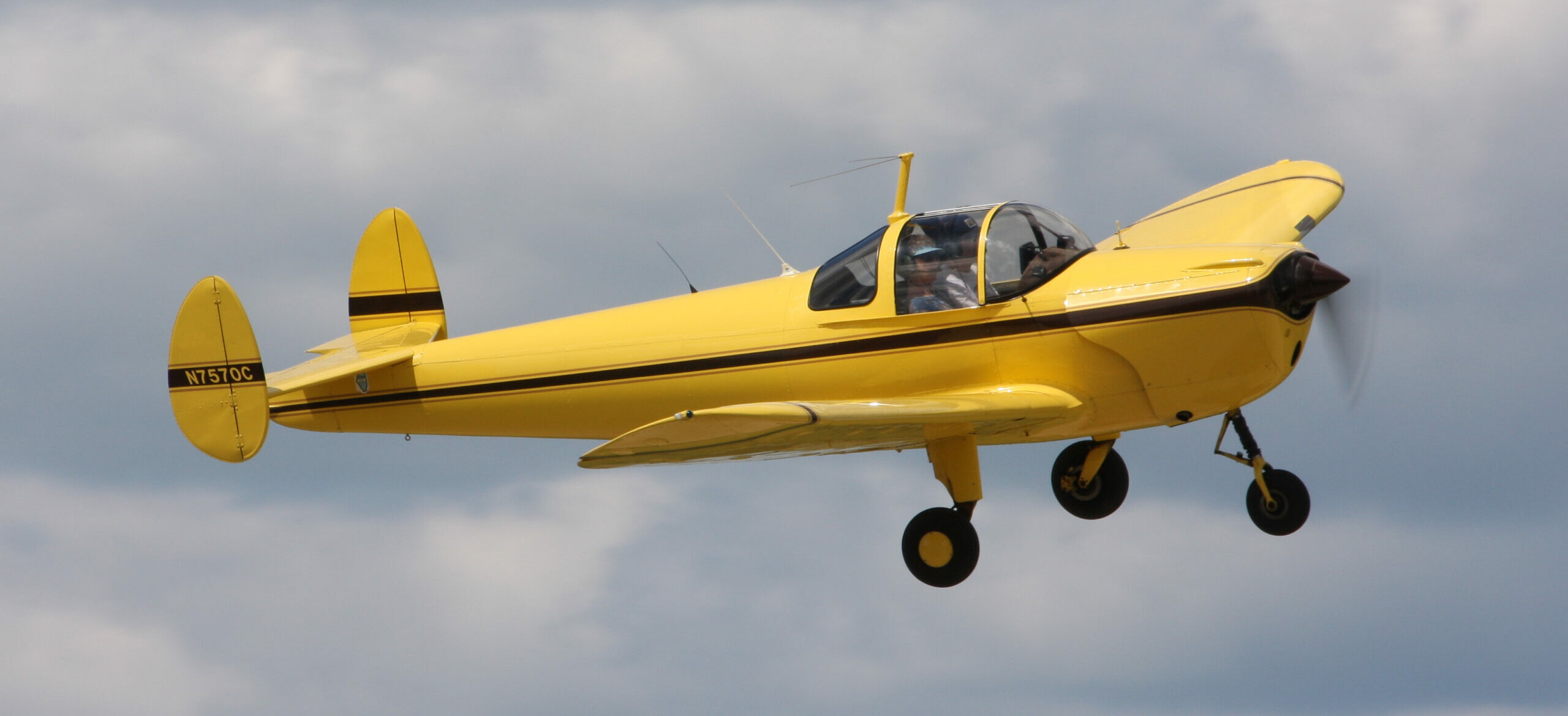 Few legacy GA aircraft are as easily recognizable as the Ercoupe. The twin tails and large glazed canopy are distinctive, as are its lack of rudder pedals (on most models). Ercoupe Owner’s Club Executive Director Gene Bunt says, “for lack of a better explanation…it’s got major ‘cute factor’.” But apart from its unique looks, the plane is also known for being easy to fly. It was, after all, designed with the goal of being the safest fixed wing aircraft available—one that would not stall or spin.
Few legacy GA aircraft are as easily recognizable as the Ercoupe. The twin tails and large glazed canopy are distinctive, as are its lack of rudder pedals (on most models). Ercoupe Owner’s Club Executive Director Gene Bunt says, “for lack of a better explanation…it’s got major ‘cute factor’.” But apart from its unique looks, the plane is also known for being easy to fly. It was, after all, designed with the goal of being the safest fixed wing aircraft available—one that would not stall or spin.
While the Ercoupe is a type certified aircraft, many of the variants qualify within the Light Sport category. When MOSAIC comes in all of them will qualify. That’s great news for Sport Pilots looking for something “different” to fly. And, they regularly show up for sale for comparatively little money.
Development
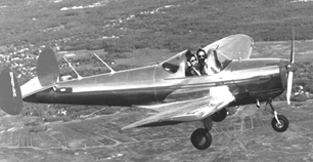
ERCO made the best of a bad situation by building Ercoupes for the military. They were used for flight instruction with the Civilian Pilot Training Program and for submarine patrol with the Civil Air Patrol. Since aluminum was in high demand for war production, wood became the primary building material for the Ercoupe. The wood variants were heavier than aluminum-based Ercoupes, but they were quieter because of wood’s ability to soak up engine and airframe vibration.
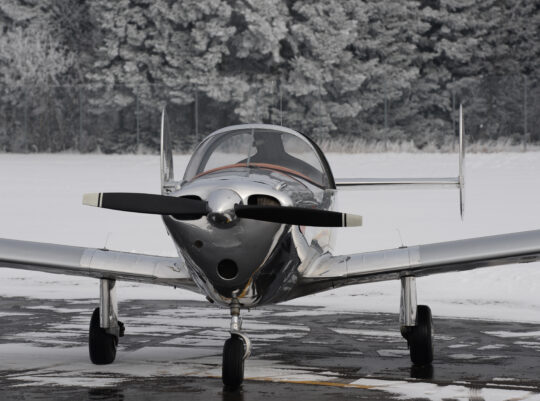
Features & Flight Characteristics
Early Ercoupes were powered by 65 hp Continental boxer engines, but the 415-C model built right after the war had a 75 hp Continental. The 415-D and 415-CD saw minor interior modifications and an increased gross weight, while the 415-E and 415-F models saw 85 and 90 hp Continentals, respectively. The 415-G Club-Air introduced a rear kiddy-seat, while the 75 hp H model Club-Air came without the kiddy-seat.
Regardless of the engine mounted and regardless of its empty weight (generally a little over 800 pounds) or MTOW, the Ercoupe offers modest performance. The instrumentation is simple, as are the vintage amenities. The plane is reportedly comfortable for pilots who have an inseam of 32-inches or less. If there are rudder pedals, however, you’ll need shorter legs. Pilots with a bit of girth can fit into an Ercoupe with a minimal amount of squeezing. Two large adults, however, are not going to find the Ercoupe very comfortable. Specifications for the variants are readily available online, but the approximate performance figures for Ercoupes are generally as follows: Max speed of 110 mph; cruise of 95 mph; stall at 48 mph; Vne of 144 mph; 300 mile range and a climb rate of 550 fpm.
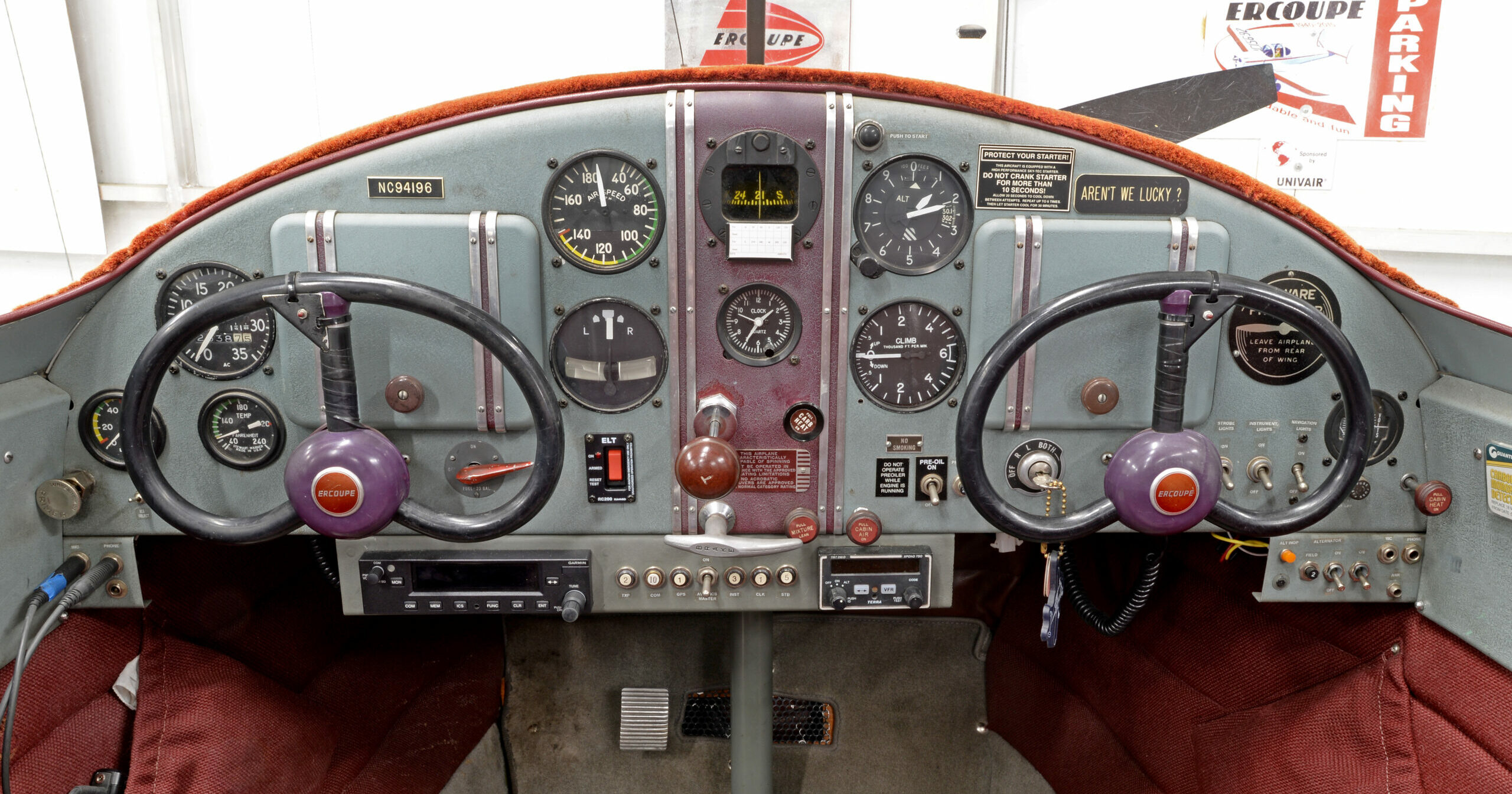
(Photo: Jason McDowell.)
Flying the plane is a relaxing treat according to Ercoupe enthusiasts. Since the rudder and front wheel are linked to the control yoke, you only need your hands to fly it. According to Bunt, stalls are nonexistent because there isn’t enough elevator movement to allow you to approach one. Instead of stalling, the plane just loses altitude at about 800 fpm. And since you can’t stall, you can’t spin! The biggest adjustment to flying an Ercoupe is the lack of rudder pedals. The plane is sometimes called the ‘Scare-Coupe’ because you don’t have any choice but to land the plane in a crab when there’s a crosswind.
“You’ll be going somewhat sideways down the runway, but don’t worry about straightening the plane before landing,” explains Bunt. “Once you touch down you need to momentarily let the yoke go so the front wheel straightens itself. Trying to correct it yourself can easily result in an overcorrection. And don’t be afraid of landing this way. Ercoupes have a crosswind component of 30-35 mph! The landing gear is specifically made to handle crabbed touchdowns.” Bunt adds that Ercoupes built with rudder pedals, or had them added later, offer only half the crosswind capabilities of the original design.
Ercoupe takeoffs are also a little bit different. The plane’s wings have a minus-3-degree angle of attack to ensure the nosewheel has positive steering during takeoff and landing rolls. No matter how fast the plane is moving on the ground it won’t take off. So, to get off the ground, Bunt says you need to “pop” the nose into the air by rapidly pulling up on the yoke to get flying, and then immediately push back down again to level off above the runway while building airspeed.
Pre-Buy Inspection
Kevin Provost, an A&P and the owner of Monadnock Choppers in Keene, NH, is working on a poorly maintained Ercoupe. He recounts that the buyer knew the plane needed quite a bit of work, so didn’t bother with a pre-buy inspection. That is proving to be a mistake. The plane’s “issues” grew substantially the further Provost dug into the aircraft. “There are areas in an Ercoupe that you really need to check unless you don’t care about getting into serious money,” he contends.
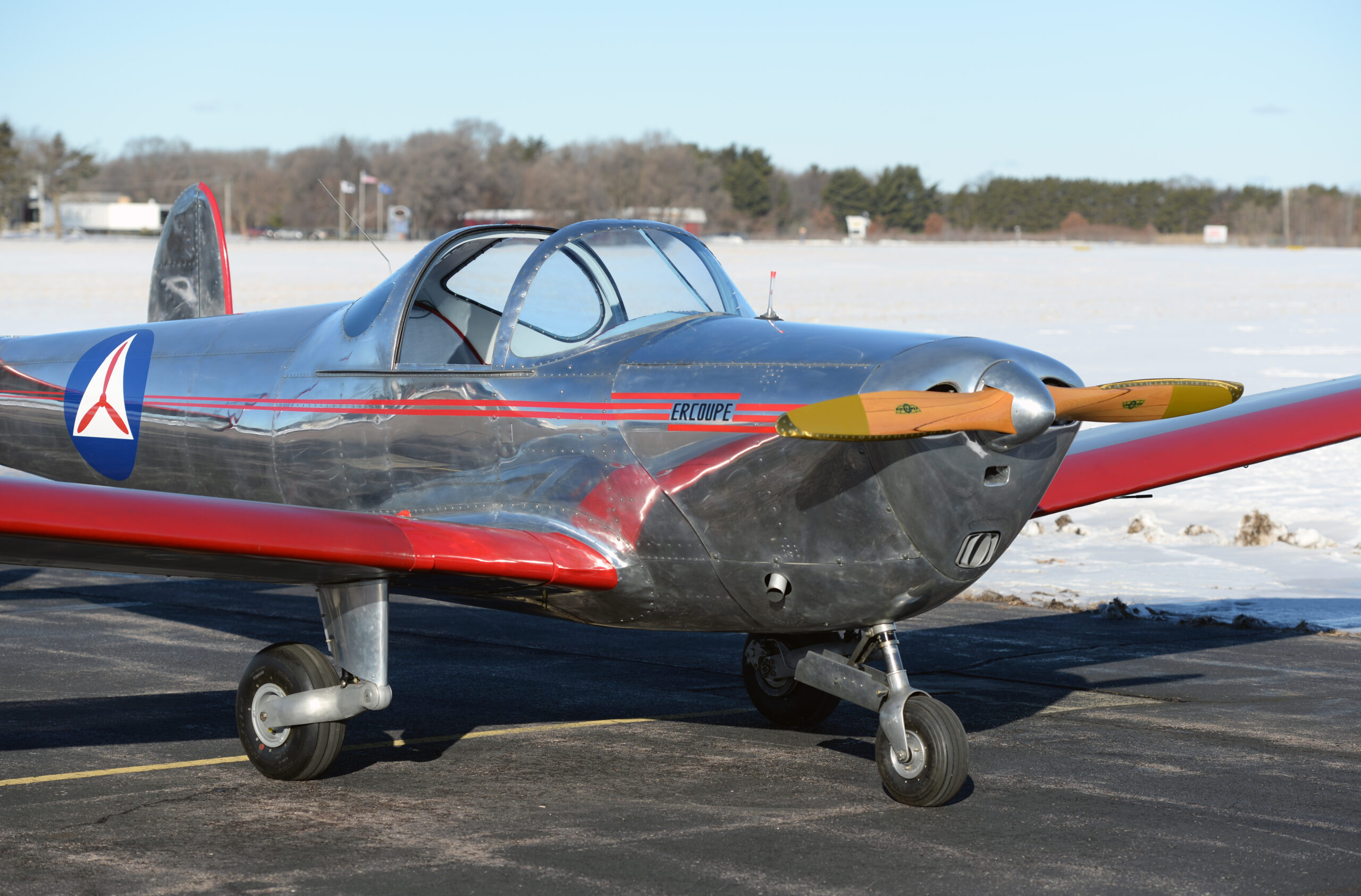
(Photo: Jason McDowell.)
The best pre-buy inspections will likely be performed by an A&P who’s familiar with Ercoupes. To help potential owners avoid the surprise of purchasing an unfit aircraft, the Ercoupe Owners Club has a free pre-purchase inspection guide available online. The guide’s creator, Ed Burkhead, says it covers what it takes to do the job right. “Realistically, most people will skip some of these steps even though many items are things the buyer can do him/herself,” writes Burkhead. “These things are listed because my advisors suggested that they were important.”
This article won’t go into specific details about doing a pre-buy on an Ercoupe given the availability of the guide. But, the most important thing to look for is corrosion. The Ercoupe isn’t especially susceptible to corrosion compared to other legacy aircraft, but corrosion in the wrong place is “cancer” for this plane, according to Burkhead. Corrosion on the outside of the plane shouldn’t be hard to identify, but finding it inside the wings or fuselage it a different story. Some early Ercoupes had fabric covered wings that were later “metalized.” The insides of the wings on these models need to be checked even more carefully for corrosion because of the potential of water leaking through the fabric.
Ownership & Maintenance
The Ercoupe may not be the best plane to take a check-ride in, as FAA standards require a pilot to demonstrate proficiency with a rudder. If you do take a check-ride in an Ercoupe you’ll be limited to only flying linked-rudder planes.
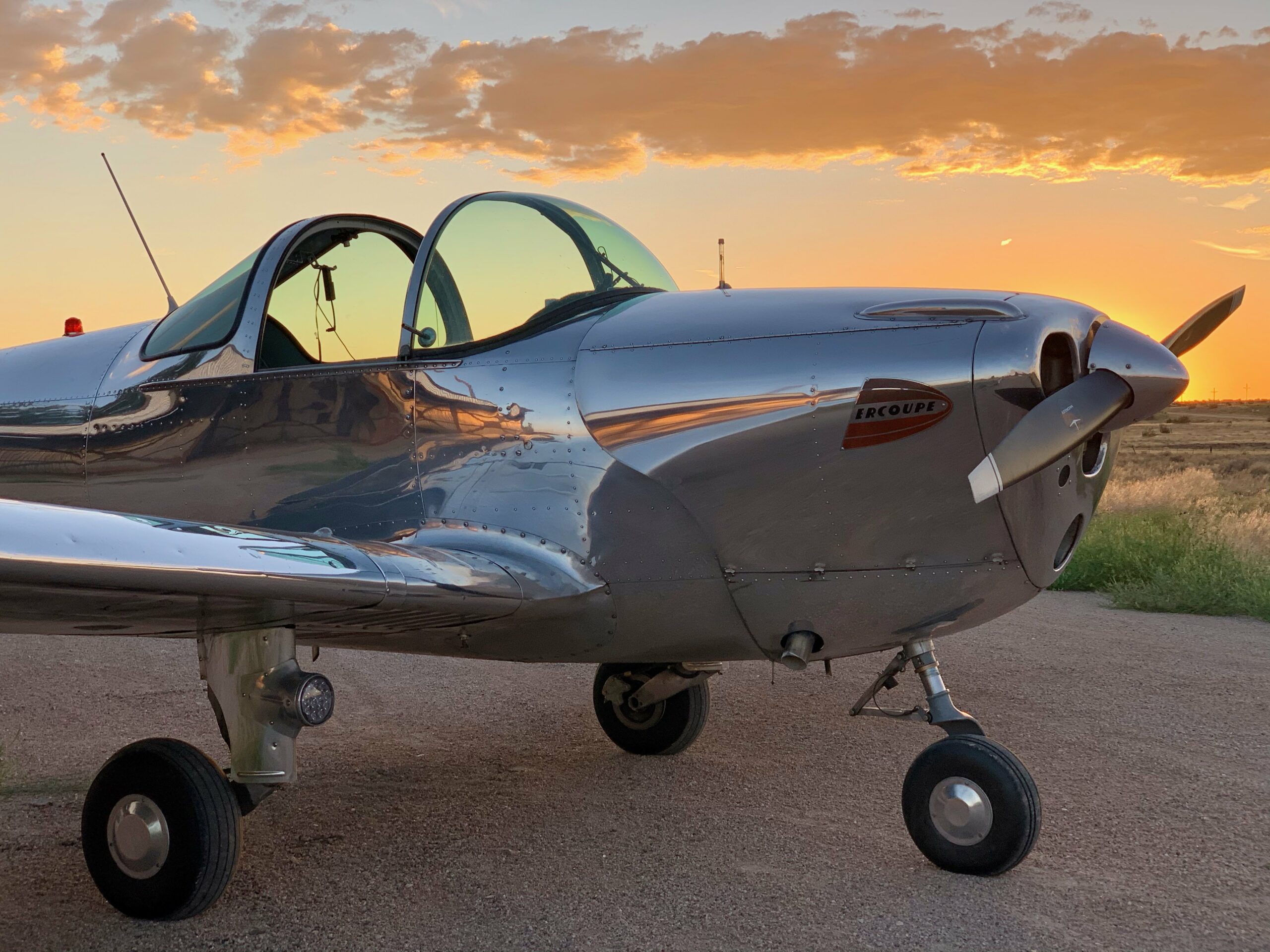
(Photo: James Good.)
Given that Ercoupes can be significantly older than their pilots, there will be age-related airframe and powerplant costs down the road. Bunt says this shouldn’t be too big a problem since parts are easy to find. “Ercoupes aren’t like most of the older planes…they used off the shelf stuff a lot of the time… a lot of standard hardware,” he details. “And, there are a lot of junk planes around if you need parts too… but the problem with them is that most Ercoupes were hand fitted so things may not line up well.”
Apart from watching for corrosion, experts say another thing to keep an eye on is the plane’s tail height. (This should be checked during the pre-buy too!) The standard landing gear’s shock absorption system will sag over time, which then changes the plane’s attitude on the ground. This, in turn, alters the minus-3-degree angle of attack discussed earlier and negatively impacts takeoff and landings.
Buying an Ercoupe allows you to join an active aviation community. The Ercoupe Owners Club is one of the largest groups with more than 600 members. There are also regular Ercoupe fly-ins, as well as EAA and Facebook interest groups. Additionally, there are a number of online sub-forums dedicated to the plane. As a major bonus, Bunt says the plane makes it very easy to make new friends. “No matter what airport you land at, people will come up to you… saying something like: My grandfather had one of those…or my first flight was in an Ercoupe. There are never ending stories surrounding this plane.”


Another good article
Thanks
Cute airplane. I only few in on two occasions back in my pre-solo (age 16) days. First time was with an older guy who I believe had owned it since it was new (this would have been around 1965-67 when I flew in it). The second time was with a guy only a few years older than me. His daddy was loaded and had just bought the plane for his son. While climbing into the cockpit I put my fat ham hock hand through the back plexiglas panel. Needless to say, that was my last flight in an Ercoupe. My late brother-in-law was a WW2 navy vet. He worked at the factory in Riverdale, Md before joining the Navy after Pearl Harbor.
The Ercoupe reminds me of a Pug dog😊 sort of squat with a pushed in nose.
My father was paralyzed in 1952
He owned 2 ercoups and earned his pilots license without the use of his legs.
I rode with him and have a fond place in my heart for this unique plane.
Funny that is has no pedals but it’s a little old. Just a touch
The rudders and nose wheel steering were tied into the aileron controls on the older Aircoupes. The idea was to make flying seem like driving a car.
My A2-A had rudder pedals
My first and most loved airplane was a 1968 Mooney/Alon A2-A. It was the last of the twin tail versions. With a 90hp Continental (95hp for take off) it would outfly and outclimb a Cessna 150/152 any day of the week. Cruise was 125 mph and a service ceiling of close to 20,000 ft (the highest I had it was 16,500 and still climbing). It sure was a delight to fly on a summer day with the canopy slide back and your elbow hanging out in the breeze. I sure wish still had it today. I don;t think I could find one for the $3,500 I paid back in 1972.
My first aircraft ownership after college; an Ercoupe 415-CD, wonderful plane. Mine had rudder pedals and I was happy with rudder pedals for cross wind landings. After about 3 years ownership; I made a hard landing and sheared the pin that holds the nose wheel in place. Though 40 years of use, and bouncing off the nose gear could have had this shear going on for over a decade; my guess. So it sat outside for over a year and was noticed by some nefarious person who cut into the elevator to take the bell cranks. Go figure. The sheriff said he had no jurisdiction. And it did not occur to me to call the FAA and no one suggested it. Even with these events, owning an Ercoupe was wonderful. I sold it to my Uncle who restored it and then he bought another and restored that one also. I flew to Oshkosh 1977 in this Ercoupe and had a wonderful time. Ercoupes do not stall; they mush in. Wonderful for a first time pilot. When the controls get mushy, you know you are flying too slow. Gages are useful except flying by the seat of your pants based on what the aircraft and the outside air are telling you is much more fun!